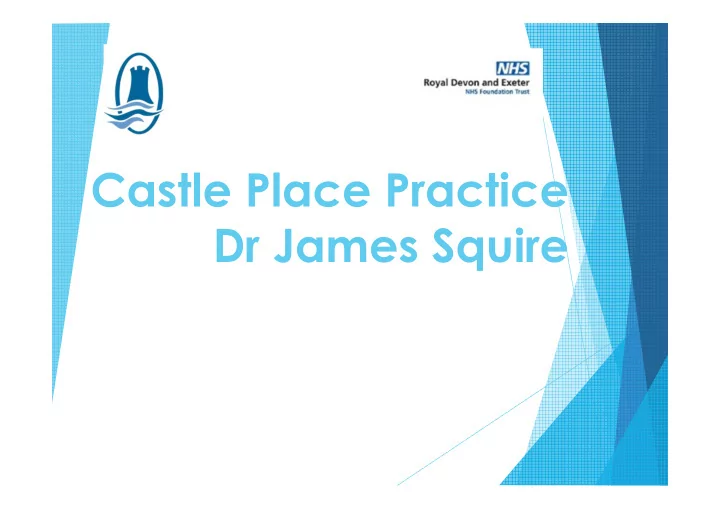

Castle Place Practice Dr James Squire
Primary Care � 90% patient contact in NHS is with Primary Care � General Practice Changing and Challenged � Pressure of rising demand, aging population, complexity of health � Decline in number of GPs, and part-time working patterns of GPs � Current Primary Care Access � Varies per area, difficulty of appointments with own GP or any GP � Being addressed locally as it arises in different ways � Continuity of Care Vs Urgent Episodical Cases � Own GP continuity still regarded as most effective for LTC patients � Any GP or other healthcare practitioner roles are developing depending on patients’ presenting issue � Improving access 8-8 by end of 2018 across Devon adds to challenges
One Practice Perspective-part of Tiverton population Castle Place Practice – access to GPs � Currently excellent, but not experienced everywhere in Devon � � Not complacent, can’t stand still and do nothing Potentially fragile, given traditional reliance on currently reducing workforce � Key to Future – Collaborative working across a place � Work with patients, health, social, community, voluntary, place local services � Collaborate to set and manage expectations, prioritise need, design solutions together � Castle Place Practice- approached RD&E � RD&E are the acute, community and social care* provider in Eastern Devon � January 2018 Castle Place Practice joined this collaboration-start of the journey � Castle Place Practice –approached Tiverton Health and Well-being Forum � Raise awareness, better engage, navigate, signpost and expand to social prescribing � � Tiverton Community Conversation (27.03.2018) –bring together active Tiverton organisations What do we do well; what are the gaps/needs; work more collaboratively to ensure we are � an active, smartly resourced and connected community Technology � Pivotal to future service provision � � Pro-active prevention work
Winter 2017/2018 SPOA (Single Point of Access)/ MTU – Service is good � SPOA –Resources for community care are improving but naturally a finite resource � Discharge/blockage � GP involvement is post discharge – We aim to work differently in future � Liaison nurses /GP dynamically linked to complex care team � Currently multi-agency and patient own GP focused � Aim for integrated and more urgent response by same day service. Prior to this point � – be more proactive and use community connections to identify and support vulnerable patients earlier - link to Tiverton Community Conversation This winter? � � Difficult flu year in some areas � Generally positive CASE STUDY � Shortage of district nurses at points put some pressure on the system � NOTE – Advise to seek official views of LMC, CCG & RDE
CASE STUDY– 90 year old � History of occasional falls � Following a Fall osteoporosis, � Rapid Response Try to hypertension Keep Home � Lives alone and uses stick, � Admission for medical family in same town needs only � Social housing 2 nd floor � Discharge facilitated by flat, no lift Rapid Response � No care package � Interventions in place to prevent further falls.
UC- Urgent Care RR – Rapid Response via Single Point of Access (SPOA) PM – Paramedic GP – Doctor CT – CT Scan COTE – Care of the Elderly Consultant Psych – Elderly Pschiatry CPP – Castle Place Assessment Team Matron – Community Matron SS – Social Services facilitated care package PRE-ADMISSION HOSPITAL POST-DISCHARGE 28/01 UC 05/02 to 23/02 23/02 CPP 30/01 Family CT Head/Pelvis 27/02 Matron 31/01 RR COTE 01/03-03/03 Fam 03/02 PM Psych 07/03 SS 05/02 GP
Benefits of This System � Patient happier in own home � Less time in hospital to decondition – better prognosis � Less confusion when at home and less risk of infections � Specialist time focused on patients with medical need � Assessments in home are more realistic � Less costly – can help more people � Good multidisciplinary working � Funding must flow appropriately
Recommend
More recommend